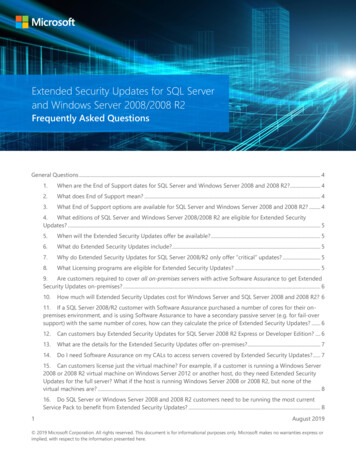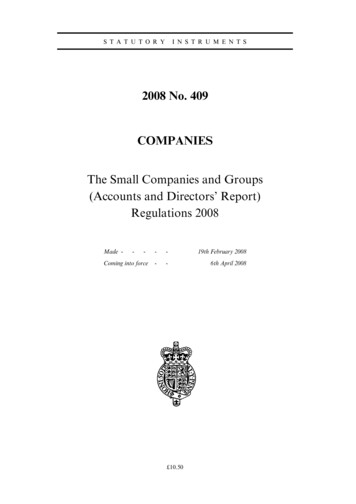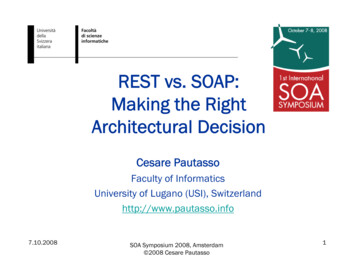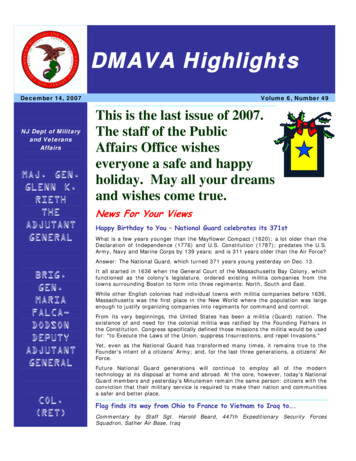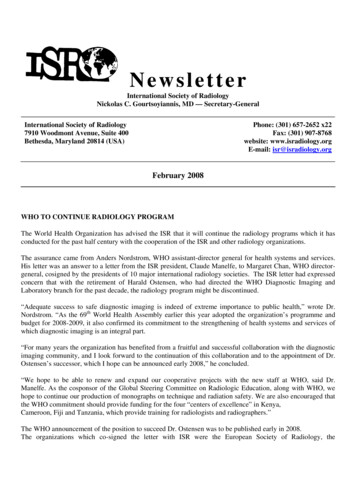
Transcription
NewsletterInternational Society of RadiologyNickolas C. Gourtsoyiannis, MD — Secretary-GeneralInternational Society of Radiology7910 Woodmont Avenue, Suite 400Bethesda, Maryland 20814 (USA)Phone: (301) 657-2652 x22Fax: (301) 907-8768website: www.isradiology.orgE-mail: isr@isradiology.orgFebruary 2008WHO TO CONTINUE RADIOLOGY PROGRAMThe World Health Organization has advised the ISR that it will continue the radiology programs which it hasconducted for the past half century with the cooperation of the ISR and other radiology organizations.The assurance came from Anders Nordstrom, WHO assistant-director general for health systems and services.His letter was an answer to a letter from the ISR president, Claude Manelfe, to Margaret Chan, WHO directorgeneral, cosigned by the presidents of 10 major international radiology societies. The ISR letter had expressedconcern that with the retirement of Harald Ostensen, who had directed the WHO Diagnostic Imaging andLaboratory branch for the past decade, the radiology program might be discontinued.“Adequate success to safe diagnostic imaging is indeed of extreme importance to public health,” wrote Dr.Nordstrom. “As the 69th World Health Assembly earlier this year adopted the organization’s programme andbudget for 2008-2009, it also confirmed its commitment to the strengthening of health systems and services ofwhich diagnostic imaging is an integral part.“For many years the organization has benefited from a fruitful and successful collaboration with the diagnosticimaging community, and I look forward to the continuation of this collaboration and to the appointment of Dr.Ostensen’s successor, which I hope can be announced early 2008,” he concluded.“We hope to be able to renew and expand our cooperative projects with the new staff at WHO, said Dr.Manelfe. As the cosponsor of the Global Steering Committee on Radiologic Education, along with WHO, wehope to continue our production of monographs on technique and radiation safety. We are also encouraged thatthe WHO commitment should provide funding for the four “centers of excellence” in Kenya,Cameroon, Fiji and Tanzania, which provide training for radiologists and radiographers.”The WHO announcement of the position to succeed Dr. Ostensen was to be published early in 2008.The organizations which co-signed the letter with ISR were the European Society of Radiology, the
Radiological Society of North America, the InterAmerican College of Radiology, the Mediterranean andAfrican Society of Ultrasound, the African Society of Radiology, the World Federation of Ultrasound inMedicine and Biology, the Asian and Oceanian Society of Radiology, the American College of Radiology andthe Radiology Outreach Foundation. The International Society of Radiographers and Radiologic Technologistssent a separate letter to WHO.In November of 2007, ISR President Claude Manelfe and Executive Director Otha Linton met with leaders ofthe International Society of Radiographers and Radiologic Technologists. In the photo, left to right areAlexander Yule, ISRRT executive director, Domenique Zeroug and Philippe Gerson, ISRRT educationcommittee members, Dr. Manelfe, Robert George, ISRRT president, and Otha Linton.ICR 2010 SET FOR SHANGHAIThe 26th International Congress of Radiology has been scheduled for 9-12 April of 2010 in the InternationalConvention Center in Shanghai, China. The formal agreement was signed between the Chinese Society ofRadiology (CSR) and the ISR in November. The Chinese Medical Association is a cooperating organization.“Better Radiology, Better Healthcare,” is the announced theme, said Ji Qi, president of the CSR. Xiaeyuan Fengof Shanghai is the chairman of the organizing committee.In the summer of that year, Shanghai will be host to World Expo 2010, an international fair that sponsors hopewill attract millions of attendees. The April date for ICR 2010 is weeks before the start of World Expo.“Shanghai stands in the front line of China’s economic development and has undergone unimaginable changesin the last two decades,” Drs. Ji and Feng wrote in a preliminary brochure. “Shanghai, as China’s biggest andmost prosperous city, oozes an atmosphere of vitality and a dynamic which can rival New York in the UnitedStates and Paris of France in terms of modernity.”ISR VIRTUAL CONGRESS DRAWS HEAVY RESPONSEMore than 1500 radiologists from 90 different countries have logged onto the first ISR virtual congress in theweeks since its opening on 3 December of last year. Some 8300 hits in the first three weeks suggests that each2
registrant visited the site an average of five times. The first world-wide virtual congress includes 40 lectures byleading radiologists from many countries, plus case reports and electronic posters. The virtual congress alsoallows electronic discussions between the speakers and registrants at times designated on the site.“This is a grand start,” said Claude Manelfe, ISR president. “Our first virtual congress will be posted on the ISRwebsite (www.isradiology) for the rest of the current year, with some possible additions during coming months.I encourage all of our national societies to tell their individual members about this exciting new service from theISR.“We are grateful to our organizing committee, Ricardo Garcia Monaco of Buenos Aires, Argentina, LuisDonoso Bach of Barcelona, Spain, and Giorgio Rizzatto of Gorigia, Italy. We also thank all of those whocontributed lectures, cases and posters,” he continued.PROGRAM SET FOR ICR 2008 IN JUNE AT MARRAKECH, MOROCCOSome 200 leading radiology teachers from 30 countries have confirmed their planned presentations on a widerange of diagnostic radiology topics on the scientific program for ICR 2008, 5-8 June of this year in Marrakech,Morocco.Many of the speakers and special sessions are sponsored by one or more of the 15 national and regionalsocieties which are collaborating organizations with the host Moroccan Society of Radiology.The formal opening session on 5 June will feature the ISR’s Beclere lecture to be presented by Elias Zerhouni, anative of Algeria and current director of the United States National Institutes of Health. The session alsoinvolves presentation of awards to contributors of case studies and posters to the first ISR virtual congress. Theawards are endowed by the Kuwait Radiology and Nuclear Medicine Society. Winners of the awards will bechosen by ISR committees for that purpose.The second ISR-sponsored lecture will be presented on Saturday 7 June by Francisco Arredondo of Guatemala,ISR past president and current chairman of the International Commission on Radiologic Education. That lectureis named for Walther Fuchs, the late IRS secretary-general.“We have planned what we believe will be an exceptional intellectual and cultural experience for everyoneattending the congress,” wrote Farida Imani, president of the organizing committee. “It will be an opportunityfor allof us to discuss and exchange ideas, learn about exciting new advances in imaging technology, andstrengthen research partnerships. The congress also will look toward the future by offering young doctors achallenging scientific program including publications and electronic posters.”The registration for radiologists will be 500 euros before 31 March and 600 euros from then to the June openingday. Residents will pay 125 euros before the end of March and 150 euros after that. Radiographers will pay 175euros and 200 euros. The fee for accompanying persons will be 125 euros and 150 euros.Detailed information about meeting registration and hotel reservations can be obtained from the ICR websitewww.icr2008.org or by writing to ISR Reservations at 424 Rue Paradis, 13008 Marseille, France. The congressfax number is 00 33(0) 491 77 04 41 and its email is www.icr2008.org.3
ISR CONTRIBUTES CONSULTATION TO BASIC SAFETY STANDARDSOver the past several years, ISR representatives have participated in the drafting of two sets of radiation basicsafety standards for patients and radiation workers being prepared by teams at the International Atomic EnergyAgency. The documents are intended as guidelines for national government health and safety ministries inpromulgating their own regulations and recommendations.“We think it is important that we share our knowledge of good radiology practice with those who approachthese standards from a regulatory perspective,” said ISR President Claude Manelfe. “Speaking for radiology tointernational bodies which are responsible for health programs is one of the primary missions of the ISR.”PRESIDENTIAL MESSAGEI have had the great privilege of being president of the International Society of Radiology during two years inwhich the society has grown in service to all of our members. Being president does not mean that I have doneall of the work, but I have been busy. We all owe a heartfelt thanks to those whose ideas and contributionsexpand our role in international education and regulation.Many of you have registered as participants in the first ISR virtual congress, which began in December and willstay active through this year. We are convinced that electronic educational programs already are vital toradiology learning in every part of the world. The technology of digital recording and imaging transmission arepart of the practice of radiology and also should be part of our teaching process for radiologists, radiographersand others reliant upon our imaging capabilities.We hope to follow this first global virtual congress with expanded programs which should cover most areas indiagnostic radiology. For those who must do much of their learning at home, these materials are available to usat our own selected time and place. This is happening and ISR is proud to be part of the world-wide effort. It isa wonderful new dimension ISR can provide to individual members of all of our national societies.We are equally indebted to Farida Imani, president of the Moroccan organizing committee for ICR 2008, toNoureddine Chakir, general secretary, to Abdelhamid Sbihi, scientific program chairman, and to MohamedBenameur, My Rachid ElHassani, Mahamed Jiddane, Rachida Dafiri, Najat Boukhrissi and Nabil Chikhaoui,members of the organizing committee for a fine job of putting together a wonderful congress. Fifteen othersocieties are collaborators. The program includes speakers from the countries represented by the collaboratingorganizations and many others, covering the full range of diagnostic imaging.I close on a familiar note. The ISR is a confederation of national radiology societies---including your society. Itcan exist and grow only with your support. One part of support is the annual membership dues you pay for yoursociety. So please pay your dues for this year and any previous years you have missed. The other part is ourneed for your advice on what you want from the ISR and how you can help to plan and conduct our programs.INTERNATIONAL COMMITTEE MEETS IN JUNE AT ICR 2008The ISR International Committee, composed of representatives of national member societies, will meet in the4
Congress Palace, REDA 1 at 2pm on 6 June in a meeting room of the convention center in Marrakech, Moroccoduring ICR 2008.Delegates will be asked to vote on technical changes to the ISR bylaws, to vote for a new slate of officers for2008 to 2010, and to vote for five societies to designate members of the ISR Executive Committee for 2008 to2010. They also will vote for five societies to designate members of the Executive Committee for the same twoyear period.The details of the meeting and requests for nominations of sponsors for Executive Committee seats and forsponsorship of future international congresses were contained in a letter from the ISR secretary-general,Nickolas C. Gourtsoyiannis, of Hercalion, Greece, to officers of all the national societies.The Executive Committee is composed of the ISR officers, representatives of five continental radiologyorganizations and five national societies. The societies holding permanent Executive Committee seats are theAsian and Oceanian Society of Radiology, the InterAmerican College of Radiology, the European Society ofRadiology, the American College of Radiology and the newly organized African Society of Radiology.The five national societies represented currently are Brazil, Germany, Australia, Kuwait and Spain. All of themand their designated appointees are eligible for re-election, if the societies choose to seek re-electionThe slate of officers as proposed by the Executive Committee include two positions which already are resolvedand three which must be voted by the International Committee. The president-elect, Hans Ringertz ofStockholm, Sweden becomes president, succeeding Claude Manelfe of Toulouse, France, who becomes pastpresident. The nominee for president-elect is Dr. Gourtsoyiannis. The designated nominee as his successor isJan Labuscagne of Pretoria, South Africa, the incumbent treasurer. The new treasurer is James Borgstede ofColorado Springs, Colorado in the USA.“Our letter to society officers also invited the national societies to express interest in sponsoring ICR 2012.Each international congress is conducted by the ISR with the cooperation of a host national society whichundertakes the organization and management of the congress,“ Dr. Gourtsoyiannis said. “Our intent is to movethe congress from continent to continent and to choose meeting cities which are not the sites of permanentradiology conventions. We invite expressions of interest in sponsoring the 27th International Congress ofRadiology before our June sessions at ICR 2008 in Marrakech, Morocco. We will be glad to provide addeddetails for any interested society.”The bylaw changes are mostly technical. Among them is recognition of the newly formed African Society ofRadiology, provision of Executive Committee action by mail ballot between regular meetings, sets theregularity of International Committee meetings as two years, at ICR sessions and makes consistent languagerelating to election of officers, he explained.5
NEW PUBLICATIONS FROM ICRPAt the end of 2007, the International Commission on Radiological Protection issued a new publication No 103,incorporating general recommendations for radiation safety in exposures to humans. The publication succeedsa series of prior broad essays, most recently No 60 issued in 1990.“The primary aim of the commission’s recommendations is to contribute to an appropriate level of protectionfor people and the environment against the detrimental effects of radiation exposure without unduly limiting thedesirable human actions that may be associated with such exposure,” the ICRP states in its introduction.“This aim cannot be achieved solely on the basis of scientific knowledge on medical radiation exposure and itshealth effects. It requires a model for protecting humans and the environment against radiation. Therecommendations are based on scientific knowledge and on expert judgement.“Radiological protection deals with two types of harmful effect. High doses will cause deterministic effects(harmful tissue reactions) often of an acute nature, which only appear if the dose exceeds a threshold value.Both high and low doses may cause stochastic effects (cancer or heritable effects), which may be observed as astatistically detectable increase in the incidences of these effects occurring long after exposure.The 330-page book can be obtained from the ICRP and its publisher, Elsevier by mail from Elsevier BooksCustomer Services, Linacre House, Jordan Hill, Oxford, 0X2 8DP, United Kingdom or from ElsevierFulfillment, 11830 Westline Industrial Drive, St. Louis, Missouri 63146 USA. Online in Britain isintl.elsevierhealth.com/series/ICRP/ and in the USA at www.elsevierhealth,com The price of the book is 116pounds, 174 euros or 232 US, plus postage.The ICRP also published four other new titles in 2007:ICRP Supporting Guidance 5: Analysis of the criteria used by the ICRP, 75 pages for 77 pounds, 117 euro or 156 US.ICRP Publication 101: Assessing dose of the representative person for the purpose of radiation protection ofthe public and the optimization of radiological protection, 104 pages, 78 pounds, 117 euros or 156.ICRP Publication 100: Human alimentary tract model for radiological protection. 300 pages, 156 pounds, 208euros or 312.ICRP Publication 96: Protecting people against radiation exposure in the event of a radiological attack. 110pages, 77 pounds, 116 euros, or 154.6
International Society of Radiology Nickolas C. Gourtsoyiannis, MD — Secretary-General International Society of Radiology 7910 Woodmont Avenue, Suite 400 Bethesda, Maryland 20814 (USA) Phone: (301) 657-2652 x22 Fax: (301) 907-8768 website: www.isradiology.org E-mail: isr@isradiology.org February 2008 WHO TO CONTINUE RADIOLOGY PROGRAM


